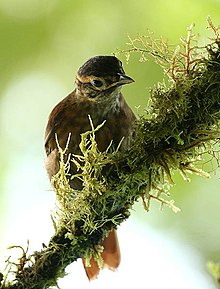
Back فرنارية Arabic فرناريه ARZ Furnariidae AST Proklavu (Furnariidae) AVK Пещаркови Bulgarian Furnariidae BR Furnàrids Catalan Furnariidae CEB Hrnčiříkovití Czech Töpfervögel German
| Ovenbirds | |
|---|---|

| |
| Scaly-throated foliage-gleaner (Anabacerthia variegaticeps) | |
| Scientific classification | |
| Domain: | Eukaryota |
| Kingdom: | Animalia |
| Phylum: | Chordata |
| Class: | Aves |
| Order: | Passeriformes |
| Parvorder: | Furnariida |
| Family: | Furnariidae Gray, 1840 |
| Subfamilies | |
Ovenbirds or furnariids are a large family of small suboscine passerine birds found from Mexico and Central to southern South America. They form the family Furnariidae. This is a large family containing around 321 species and 71 genera. The ovenbird (Seiurus aurocapilla), which breeds in North America, is not a furnariid – rather it is a distantly related bird of the wood warbler family, Parulidae.
The ovenbirds are a diverse group of insectivores which get their name from the elaborate, vaguely "oven-like" clay nests built by the horneros, although most other ovenbirds build stick nests or nest in tunnels or clefts in rock.[1] The Spanish word for "oven" (horno) gives the horneros their name. Furnariid nests are always constructed with a cover, and up to six pale blue, greenish or white eggs are laid. The eggs hatch after 15 to 22 days, and the young fledge after a further 13 to 20 days.[2]
They are small to medium-sized birds, ranging from 9 to 35 cm in length.[2] While individual species often are habitat specialists, species of this family can be found in virtually any Neotropical habitat, ranging from city parks inhabited by rufous horneros, to tropical Amazonian lowlands by many species of foliage-gleaners, to temperate barren Andean highlands inhabited by several species of miners. Two species, the seaside and the surf cinclodes, are associated with rocky coasts.
- ^ Remsen, J. V., Jr. 2003. Family Furnariidae (ovenbirds). Pages 162–357 in J. del Hoyo, A. Elliott and D. A. Christie eds. Handbook of the birds of the world, Vol. 8, broadbills to tapaculos. Lynx Edicions, Barcelona.
- ^ a b Willis, Edwin O. (1991). Forshaw, Joseph (ed.). Encyclopaedia of Animals: Birds. London: Merehurst Press. pp. 162–163. ISBN 978-1-85391-186-6.